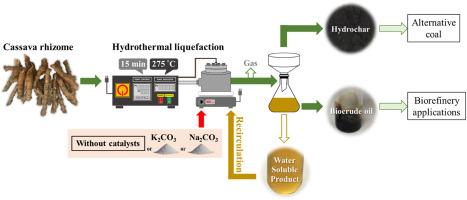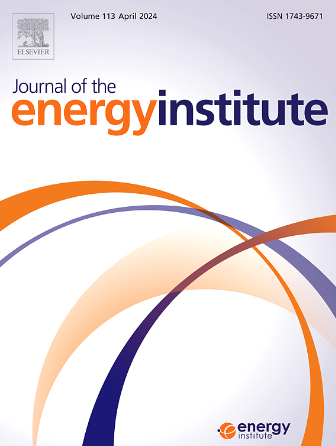Enhancing biofuel production in hydrothermal liquefaction of cassava rhizome through alkaline catalyst application and water-soluble product recirculation
IF 5.6
2区 工程技术
Q2 ENERGY & FUELS
引用次数: 0
Abstract
Hydrothermal liquefaction (HTL) possesses an outstanding biomass thermal conversion technology for producing biocrude oil (BO). Here, cassava rhizome (CR) was converted into BO via catalytic HTL using 1.0–10.0 wt% of K2CO3 and Na2CO3 with water-soluble product (WSP) recirculation at 275 °C for 15 min. The catalysts and WSP recirculation could enhance the BO fuel properties. The dominant BO yield of 38.00 and 34.80 wt% and HHV of 25.42 and 25.92 Mj/kg were derived using 4.0 wt% of K2CO3 and Na2CO3, respectively. Chemical compositions of the BO were principally phenols and hydrocarbons, which can be further upgraded and fractionated into alternative biofuels. On the other hand, the mass yield and HHV of the hydrochar (HC) co-product were reduced by the alkaline catalysts, while being maintained by WSP recirculation. The HC fuel characterization elucidated that the HC can be used as an alternative to coal. Furthermore, WSP characterization determined that organic acids were the major composition of the WSP. Thus, WSP recirculation can enhance CR decomposition according to the proposed reaction mechanism. These results indicate that the alkaline application and WSP recirculation constitute a dominant method for enhancing biofuel production via HTL.

通过应用碱性催化剂和水溶性产品再循环,提高木薯根茎水热液化过程中的生物燃料产量
水热液化(HTL)是生产生物原油(BO)的一种出色的生物质热转化技术。在此,使用 1.0-10.0 wt% 的 K2CO3 和 Na2CO3 以及水溶性产物(WSP)在 275 °C 下循环 15 分钟,通过催化热液化将木薯根茎(CR)转化为生物原油。催化剂和水溶性产物再循环可提高煤层气燃料的性能。在使用 4.0 wt% 的 K2CO3 和 Na2CO3 时,煤层气的主要产率分别为 38.00 和 34.80 wt%,HHV 分别为 25.42 和 25.92 Mj/kg。生物碱的化学成分主要是酚类和碳氢化合物,可进一步升级和分馏为替代生物燃料。另一方面,在碱性催化剂的作用下,碳氢化合物(HC)副产品的质量产率和 HHV 均有所降低,而 WSP 再循环则可保持其质量产率和 HHV。碳氢化合物燃料特性分析表明,碳氢化合物可用作煤的替代品。此外,WSP 表征确定有机酸是 WSP 的主要成分。因此,根据所提出的反应机制,WSP 再循环可促进 CR 分解。这些结果表明,碱性应用和 WSP 再循环是通过 HTL 提高生物燃料生产的主要方法。
本文章由计算机程序翻译,如有差异,请以英文原文为准。
求助全文
约1分钟内获得全文
求助全文
来源期刊

Journal of The Energy Institute
工程技术-能源与燃料
CiteScore
10.60
自引率
5.30%
发文量
166
审稿时长
16 days
期刊介绍:
The Journal of the Energy Institute provides peer reviewed coverage of original high quality research on energy, engineering and technology.The coverage is broad and the main areas of interest include:
Combustion engineering and associated technologies; process heating; power generation; engines and propulsion; emissions and environmental pollution control; clean coal technologies; carbon abatement technologies
Emissions and environmental pollution control; safety and hazards;
Clean coal technologies; carbon abatement technologies, including carbon capture and storage, CCS;
Petroleum engineering and fuel quality, including storage and transport
Alternative energy sources; biomass utilisation and biomass conversion technologies; energy from waste, incineration and recycling
Energy conversion, energy recovery and energy efficiency; space heating, fuel cells, heat pumps and cooling systems
Energy storage
The journal''s coverage reflects changes in energy technology that result from the transition to more efficient energy production and end use together with reduced carbon emission.
 求助内容:
求助内容: 应助结果提醒方式:
应助结果提醒方式:


